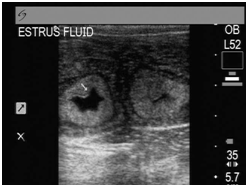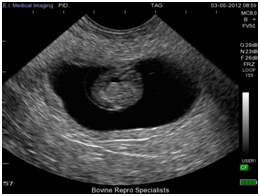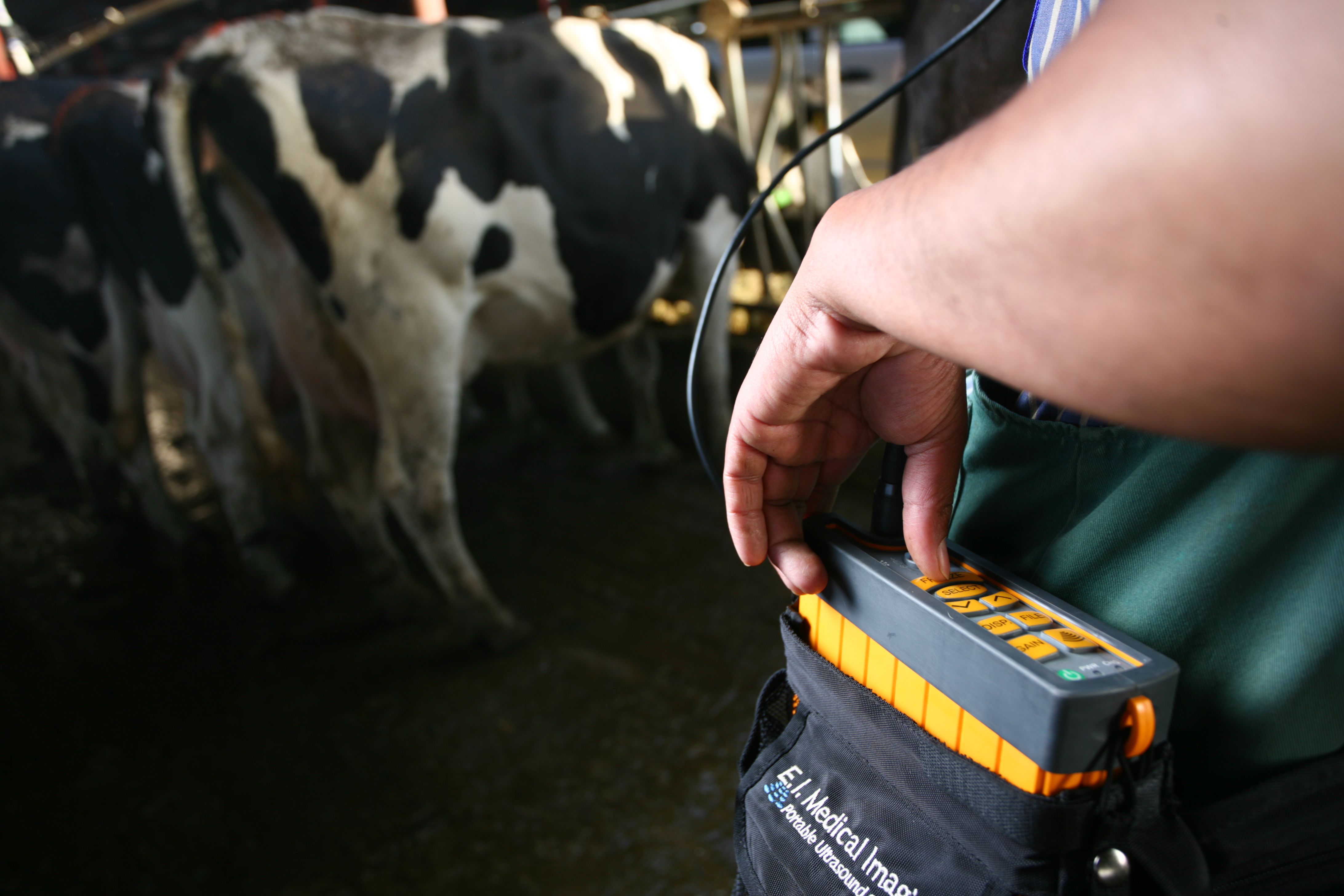written by Kevin McSweeney
International Bovine Training Solutions, http://bovinetraining.com/

What Type of Transducer Do You Use For Bovine Reproductive Ultrasound?
Even if you have narrowed down your choice of an ultrasound to buy, your decisions might not be over. Usually ultrasounds are sold with many different choices of transducers that you attach to the main unit. The transducer is the thing on the end of the cord that produces and receives the sound waves that bounce off of tissue and structures to give us an image. For reproduction in cattle the usual choice is a linear transducer, which produces a rectangular image.


Ibex ultrasound transducer shown above; L6.2 Linear Transducer (8-5MHz Multi-frequency Transducer)
However, linear transducers are not your only option, nor always the best for cattle reproduction. There is also the curved linear transducer, which produces a pie-shaped image.


Ibex ultrasound transducer shown above; MC8.0 Micro Convex Transducer (10-6MHz Multi-frequency Transducer)
As I mentioned, historically most people use the straight linear transducer for reproductive work in cattle. Why is this? I think the main reason is precedent and habit.
When ultrasound was first researched in animal agriculture reproduction, it was done by O.J. Ginther at the University of Wisconsin, and the first species studied was horses. Horses have a rectum that can be torn and when that happens, it is extremely life threatening. Take a look at the images of the two different transducers above. The dark grey surfaces on the transducer are where the sound waves come out, and those surfaces need to be pressed flat against the rectal wall to get a good image. If you notice, the curved linear transducer has a shorter surface that is on the end of the transducer, so when you want to get an image you need to point that end into the rectal wall. I think Dr. Ginther wanted to minimize the risk of tearing the rectal wall, and avoided anything that created a more pointed orientation inside the rectum. After researching horses, Dr. Ginther then moved into cattle, and I think they just stuck with the linear transducer, even though the same concerns do not exist for cows. It is much harder to tear the rectal wall in cattle, and in the unfortunate instance that it does happen (which in my 15 years of scanning has only happened once and it was in a heifer with severe diarrhea, and I think a compromised rectal wall), cows are very good at handling those things, and it does not create a life threatening condition.
I originally learned ultrasound using a linear transducer, but this work was mostly done with an Aloka 500 table top machine, mostly inside a chute, which didn’t require the machine to be portable. However, when I started a masters degree after veterinary school it was focused on dairy cattle reproduction and all the scanning needed to take place out in the pens with the cows restrained in lock-ups. This required something portable, but at the time there were not many choices that had the image quality I needed for my work. The one option at the time was the Sonosite 180, which was a machine designed for battlefield medics after the first Persian Gulf War; however, they had no need for a linear transducer and as result made none. They did have a curved linear transducer, and I began to convert over to it. After about a half a morning using it, I was hooked. Since that time Sonosite made a linear transducer for the veterinary market, but I refused to switch back, because I felt the curved linear was the better option. And now, I use an E.I. Medical Ibex, and helped them to develop a curved linear transducer that is very much like the Sonosite transducer that I used before.

Why do I like the curved linear better?
1- It is easier to get better contact with the curved linear than the straight linear. In order to get good images with the ultrasound, you need to have good contact between the transducer surface that is emitting the sound waves and the tissue that it is contacting (in the case of bovine reproduction, it is the rectal wall). The sound waves cannot pass through feces or air very well and will produce very poor images on the screen. The curved linear transducer has a smaller surface that produces the sound waves, so there is less potential space for interference or poor contact. Another thing is the conducting surface is on the end of the transducer, which makes it easier to press into the rectal wall. All you have to do is point, as opposed to the linear, which requires a more broad/flat push to maintain contact with the rectal wall. I find this to be most important for people that are just beginning to learn. They have a very hard time getting good contact between the rectal wall and the linear transducer, and as a result produce very poor images. It is very hard to learn if you cannot see what you are looking at. This ease of attaining good contact also creates much less strain on the arm of the person scanning.
2- Fetal sexing is much easier. If you progress to the skill set of fetal sexing, consider a curved linear. Fetal sexing is all about fetal orientation. You need to see certain structures (genital tubercle or genitals) in relation to other structures to be able to confidently determine the sex of the fetus. In order to do this you need to be able to change the position of the fetus to get those images, unless you are extremely lucky, and the fetus is always in the right position. In that case you need to quickly book a flight to Las Vegas and start playing the slots. But for most of us, this will not be the case, and we will find the fetus in a position that does not lend itself to determining the sex. To change the position of this fetus requires drastic hand movements with a linear transducer, but with the curved linear, it is just a simple twist of the transducer since the sound waves are emitted from the end. You will be able to attain the position you want much faster and with less arm strain using the curved linear.
3- You will only need one transducer if you are a mixed animal veterinary practice. Since the curved linear is preferable for any abdominal work, you will only need to purchase the one transducer, saving thousands of dollars for your practice.
One last thing to consider when choosing a transducer is the megahertz (MHz) of the transducer. The megahertz is essentially the frequency of the sound waves, and determines the depth at which you will scan things. Most transducers sold range from 2-15 MHz, with the lower number being able to penetrate much deeper/further. Historically, bovine reproduction has mostly used 5 MHz, but it is nice to have options. If you are scanning a cow that has a very deep uterus and you can’t quite reach the fetus, it is nice to have a lower MHz transducer to give you a few more inches. In the past, if you wanted to change your megahertz you would have to buy another transducer, but now they make transducers that scan constantly in a range of megahertz. These are called broad bandwidth transducers, and they allow you to instantly change the depth that you want to scan. These are by far the best option when you are using an ultrasound. Make sure the range of megahertz is the range you want to scan.
Interested in more bovine ultrasound training? Click here to see upcoming courses at E.I. Medical Imaging or contact International Bovine Training Solutions for customized training to meet your needs.














